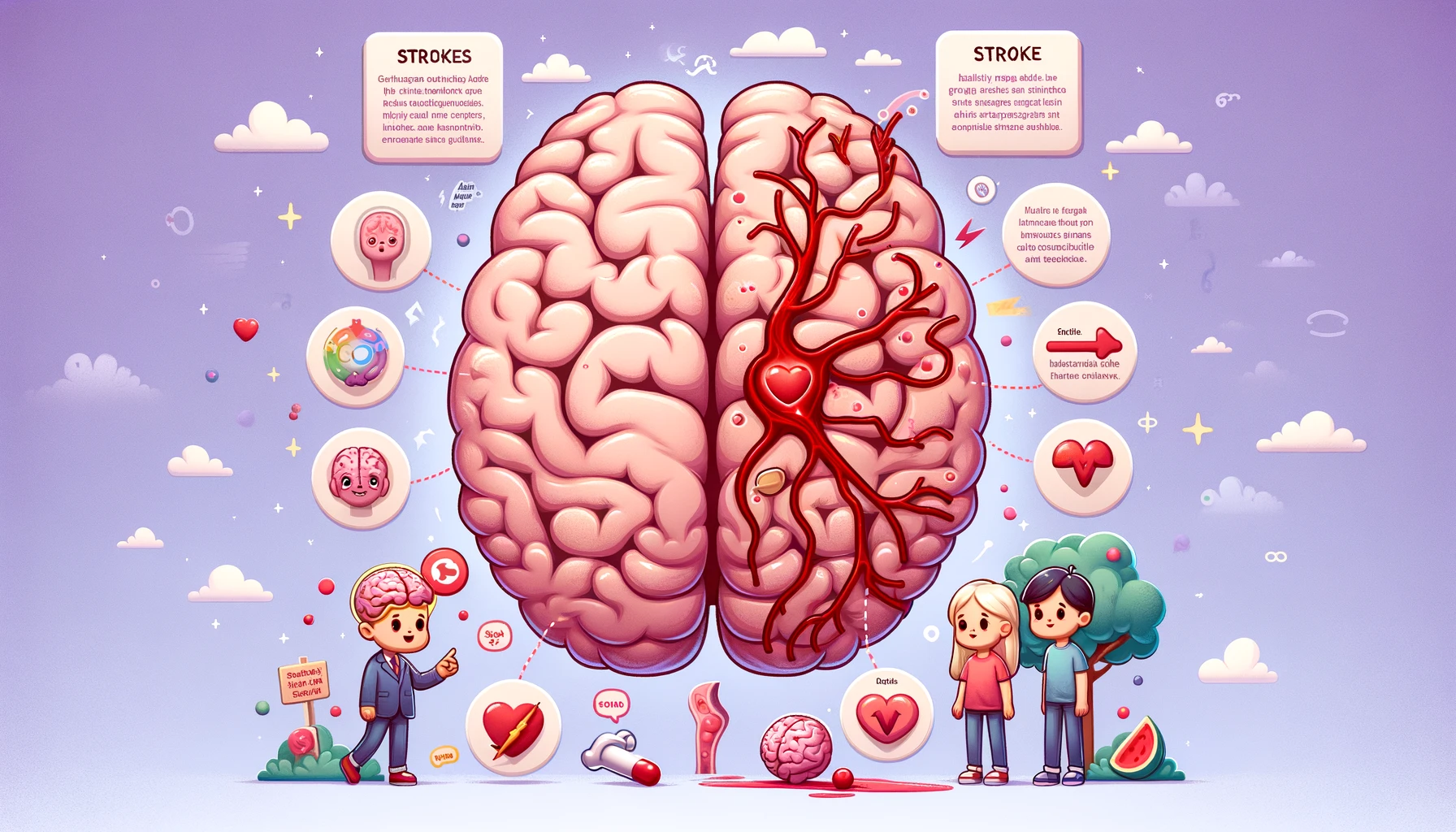Understanding Strokes: Causes, Symptoms, and Treatments
Understanding Strokes: Causes, Symptoms, and Treatments
Table of Contents
- Introduction to Strokes
- Causes of Strokes
- Ischemic Stroke
- Hemorrhagic Stroke
- Symptoms of Strokes
- Risk Factors for Strokes
- Diagnosis of Strokes
- Treatment of Strokes
- Emergency Treatments
- Medications
- Surgical Options
- Rehabilitation
- Prevention Strategies
- Conclusion
- References
Understanding Strokes: Causes, Symptoms, and Treatments
Introduction to Strokes A stroke is a medical emergency that occurs when the blood supply to part of the brain is interrupted or reduced, depriving brain tissue of oxygen and nutrients. Within minutes, brain cells begin to die. Understanding the causes, symptoms, and treatments of strokes is crucial for improving outcomes and reducing the risk of long-term complications.
Causes of Strokes Strokes can be classified into two main types: ischemic and hemorrhagic.
Ischemic Stroke
Ischemic strokes account for about 87% of all strokes and occur when a blood clot blocks or narrows an artery leading to the brain. The major causes include:
- Thrombosis: A clot forms in one of the arteries supplying blood to the brain.
- Embolism: A clot forms elsewhere in the body and travels through the bloodstream to the brain.
Hemorrhagic Stroke
Hemorrhagic strokes occur when a blood vessel in the brain bursts, leading to bleeding in or around the brain. The major causes include:
- Aneurysm: A weakened area in a blood vessel wall that bulges and can burst.
- Arteriovenous Malformation (AVM): An abnormal connection between arteries and veins that can rupture.
- High Blood Pressure: Chronic hypertension can weaken blood vessels, leading to rupture.
Symptoms of Strokes Recognizing the symptoms of a stroke is crucial for timely intervention. Common symptoms include:
- Sudden Numbness or Weakness: Particularly on one side of the body (face, arm, or leg).
- Confusion: Difficulty speaking or understanding speech.
- Vision Problems: Sudden trouble seeing in one or both eyes.
- Difficulty Walking: Dizziness, loss of balance, or lack of coordination.
- Severe Headache: Sudden, severe headache with no known cause.
FAST Acronym
The FAST acronym helps remember the signs of a stroke:
- Face drooping: Does one side of the face droop or feel numb?
- Arm weakness: Is one arm weak or numb?
- Speech difficulty: Is speech slurred or hard to understand?
- Time to call 911: If any of these symptoms are present, call emergency services immediately.
Risk Factors for Strokes Several factors increase the risk of having a stroke:
- High Blood Pressure: The leading risk factor for strokes.
- Diabetes: Increases the risk of stroke.
- Heart Disease: Conditions such as atrial fibrillation can lead to strokes.
- Smoking: Damages blood vessels and increases stroke risk.
- High Cholesterol: Can lead to atherosclerosis, increasing stroke risk.
- Obesity: Excess weight increases the risk of stroke.
- Physical Inactivity: Lack of exercise contributes to multiple stroke risk factors.
- Unhealthy Diet: Diets high in saturated fats, trans fats, and cholesterol increase stroke risk.
- Alcohol and Drug Use: Excessive alcohol consumption and illicit drug use can increase the risk of stroke.
- Age: The risk of stroke increases with age.
- Family History: A family history of stroke increases the risk.
Diagnosis of Strokes Diagnosing a stroke involves a combination of clinical evaluation and imaging tests:
Clinical Evaluation
- Physical Examination: Assessment of neurological function and symptoms.
- Medical History: Review of the patient’s medical history and risk factors.
Imaging Tests
- CT Scan: Can detect bleeding in the brain and distinguish between ischemic and hemorrhagic strokes.
- MRI: Provides detailed images of brain tissue and can detect brain damage caused by a stroke.
- Carotid Ultrasound: Examines the carotid arteries for plaque buildup.
- Cerebral Angiography: Provides detailed images of the blood vessels in the brain.
Treatment of Strokes Immediate treatment can minimize brain damage and improve recovery outcomes.
Emergency Treatments
- Ischemic Stroke:
- Clot-Busting Drugs: Tissue plasminogen activator (tPA) can dissolve clots if administered within a few hours of symptom onset.
- Mechanical Thrombectomy: A procedure to remove the clot using a catheter.
- Hemorrhagic Stroke:
- Emergency Measures: Controlling bleeding, reducing pressure in the brain, and stabilizing vital signs.
Medications
- Antiplatelet Agents: Such as aspirin, help prevent new clots from forming.
- Anticoagulants: Such as warfarin, reduce the blood’s ability to clot.
- Blood Pressure Medications: Help manage hypertension and reduce stroke risk.
- Cholesterol-Lowering Drugs: Such as statins, help reduce plaque buildup.
Surgical Options
- Carotid Endarterectomy: Removes plaque from the carotid arteries to prevent stroke.
- Aneurysm Clipping or Coiling: Procedures to manage aneurysms and prevent rupture.
- Arteriovenous Malformation (AVM) Repair: Surgical procedures to repair AVMs.
Rehabilitation
Stroke rehabilitation helps regain lost skills and improve quality of life:
- Physical Therapy: Helps restore movement and coordination.
- Occupational Therapy: Assists with daily activities and regaining independence.
- Speech Therapy: Helps with communication skills and swallowing.
- Psychological Support: Addresses emotional and psychological impacts of a stroke.
Prevention Strategies Preventing strokes involves managing risk factors and adopting a healthy lifestyle:
- Healthy Diet: Emphasize fruits, vegetables, whole grains, and lean proteins while reducing intake of saturated fats, trans fats, and sodium.
- Regular Exercise: Aim for at least 150 minutes of moderate-intensity aerobic exercise each week.
- Weight Management: Maintain a healthy weight through diet and exercise.
- No Smoking: Avoid smoking and exposure to secondhand smoke.
- Limit Alcohol: Consume alcohol in moderation.
- Manage Health Conditions: Control high blood pressure, diabetes, and cholesterol through medication and lifestyle changes.
- Regular Check-Ups: Monitor your health with regular visits to your healthcare provider.
Conclusion Understanding strokes is essential for recognizing symptoms, seeking timely treatment, and implementing preventive measures. By managing risk factors and adopting a healthy lifestyle, individuals can reduce their risk of stroke and improve their overall health.
<ⓒ WizardMedics (wizardmedics.com)>



